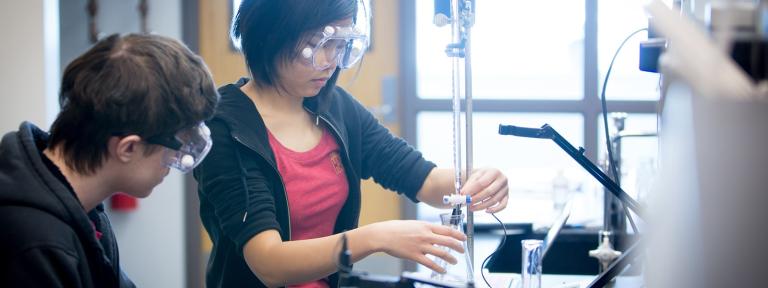
“But ancient people, they didn’t just eat the fruit, they probably ate a little bit of everything. In fact, many commonly discarded fruit and seed parts can be found in traditional herbal compounds and remedies.”
What do grape stems, walnut husks, pomegranate peels and chokeberries have in common? They are all disposable, but an interdisciplinary team of applied biologists, chemists and chemical engineering students and faculty at Kettering University are also trying to discover whether they possess medicinal values such as antioxidant, anti-microbial, anti-inflammatory, or even anti-cancer activities.
“If you think about it, we eat the fruits of these substances because they taste good and have nutritious value,” said Cheryl Samaniego, Applied Biology professor at Kettering University. “But ancient people, they didn’t just eat the fruit, they probably ate a little bit of everything. In fact, many commonly discarded fruit and seed parts can be found in traditional herbal compounds and remedies.”
Samaniego partnered with faculty Dr. Jonathan Wenzel (Chemical Engineering), Dr. Lihua Wang (Inorganic Chemistry), Dr. Ali Zand (Organic Chemistry) and Dr. Michelle Ammerman (Molecular Biology) on this research in the fall of 2013. The research team built a reactor that would elevate the temperature and pressure of fluids to create a “supercritical fluid” – where the dissolved fluids act both like a liquid and a gas simultaneously. It’s thicker like a liquid, but fills a container like a gas.
Students Anastacia Shaffer, Carolyn Jagadics and Jillian Radtke.
“When you reach that point where a fluid exists in a way like both states of matter – you reach the supercritical point. At that point, solvents have really unique properties,” Samaniego said. “For example, a polar solvent may become non-polar.”
The substances, in this case fruit residues, maintain unique properties and resist degradation seen in traditional extraction methods, even after the extracting fluid returns from the supercritical point. The substances are then tested for medicinal properties such as antioxidant activity. Antioxidants help prevent the deterioration of human cells and are known to have anti-cancer properties as well.
“We have extracted many antioxidants from these experiments, and what is exciting about this is that by varying the conditions in the reactor, we can extract different compounds in different proportions,” Samaniego said. “In pharmaceutical research, we find that drugs work better, even synergize in tandem with secondary compounds, so we may find unique combinations that can really help patients of various diseases.”
Samaniego and Wang co-authored the paper titled, "Determination of antioxidant activities of superheated ethanol extracts of grape stems," and presented a poster discussing their findings at the 248th American Chemical Society National Meeting from August 10-14 in San Francisco, California. The poster was also a part of the Division of Agricultural and Food Chemistry and was also one of the elite few that was selected for a presentation at the conference's Scimix on August 11.
(Left to right) Dr. Cheryl Samaniego, Anastacia Shaffer, Dr. Steven Nartker, Dr. Michelle Ammerman and Dr. Lihua Wang.
Senior Anastacia Shaffer, a Biochemistry major and Biology minor, worked with Samaniego and Wang on this project by performing antioxidant assays of fruit extracts in the lab. Shaffer presented the research team’s findings at the Michigan Academy of Science Arts and Letters conference in February 2014 at Oakland University.
“One of the cool things about the project was learning about the different applications and collaborations between the different groups in our department,” Shaffer said. “I appreciated the ability to do the chemistry and biology side of the project.”
Part of Shaffer’s motivation for participating in the biological side of the research was to complement her co-op experience at Lubrizol, a specialty consumer chemicals company in Ohio. At Lubrizol she was exclusively performing chemical techniques for organic synthesis.
“I wanted to do more of the biology side of it since I was working in a chemistry lab all day,” Shaffer said.
This project is unique because of the intensive collaboration between departments. Samaniego and her fellow faculty members have developed a culture of research that fosters creativity and encourages students to think critically and outside the box. They provide students the opportunity to learn technical laboratory skills and help them explore and even challenge prevailing theories and practice of the science. This is fueled by interdisciplinary relationships and cooperation between faculty members which established the precedent for students to follow their lead. Students have the opportunity to participate in bi-weekly interdisciplinary team meetings, where they are encouraged to share articles from their field, their data, and also to understand the breadth of the project, and not just their own discipline.
“We can answer more real world solutions by putting our heads together because we all see things from different angles,” Samaniego said. “I think that’s the most fun aspect of doing research at Kettering – this is real science. This is not science in a bubble.”